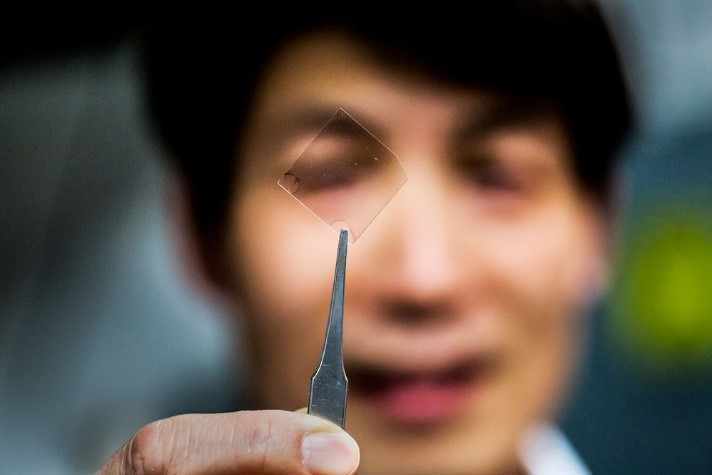By combining silver with a smidge of aluminum, researchers found a way to produce exceptionally thin, smooth layers of silver that are resistant to tarnishing. Then, they applied an anti-reflective coating to make one thin metal layer up to 92.4 percent transparent.
The result?
The thinnest, smoothest layer of silver that can survive air exposure. The discovery could change how touchscreens and flat or flexible displays are made. The researchers also found that the material guides light 10 times faster, compared to other metal waveguides, which could improve computing power, as well.
A CHALLENGER TO INDIUM TIN OXIDE
The discovery, made by researchers at the University of Michigan, could prove a worthy alternative to the gold standard of materials used to coat touchscreen and flat displays of smartphones, tablets and TVs—indium tin oxide (ITO). The material, which offers excellent transparency and electrical conductive properties, has been used in screen anodes for decades. But, its brittleness and inflexibility has had researchers searching for alternatives.
"The transparent conductor market has been dominated to this day by one single material," said
The discovery comes at a propitious time, as
indium tin oxide is projected to become expensive as demand for touch screens continues to grow. According to L. Jay Guo, professor of
electrical engineering and computer science at the University of Michigan, few known sources of indium exist. "Before, it was very cheap," he says about ITO. "Now, the price is rising sharply."
Screens require transparent electrodes to control which pixels are lit up, but touchscreens particularly depend on them. A modern touch screen, made of a transparent conductive layer covered with a nonconductive layer, senses electrical changes where a conductive object like a finger is pressed against the screen.
However, it's nearly impossible to make a continuous layer of silver thinner than 15 nanometers, or about 100 silver atoms. Silver tends to cluster together in "small islands" rather than extend into an even coating, Guo says.
By adding about 6% aluminum, the researchers coaxed the metal into a film of less than half that thickness—seven nanometers. When it was exposed to air, the layer didn't immediately tarnish as pure silver films do. And, after several months, the film retained its conductive properties and transparency. It remained firmly attached, too, whereas pure silver can be removed off glass with Scotch tape.
THINNEST OF SILVER LAYERS OFFERS OTHER POTENTIAL BENEFITS
Silver In addition to its potential to serve as transparent conductor for touch screens, the thin silver offered two more benefits, both having to do with silver's unparalleled ability to transport visible and infrared light waves along its surface.
Because the light travels with a much shorter wavelength as it moves along the metal surface, the film acts as a superlens. Or, to make out even smaller features, the thin silver layers can be alternated with a dielectric material, such as glass, to make a hyperlens. This type of lens can image objects that are smaller than the wavelength of light, which would blur in an optical microscope. It can also enable laser patterning—such as is used to etch transistors into
silicon chips today—to achieve smaller features.
So, indium tin oxide, there's a new sheriff in town. And its star is made of silver, not tin.





